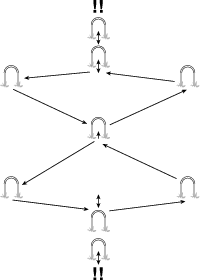Croquet
Croquet
Croquet is a great game to have set up and ready to go for a backyard barbecue. It's a slow game of patience and precision and a great way to spend time chatting with your friends as you work your ball through the course. Croquet may be an ancestor of Billiards and Golf. The goal is to use a wooden mallet to hit a ball through a hole. Sound familiar?
Winning Plays
Croquet has its origins in France and dates back as far as the thirteenth century. It migrated to England in about the sixteenthcentury and is still a popular game today.
The game is fine for kids to play—as long as they are big enough to hold the mallet; they are old enough to play.
You can buy a croquet set for under $100.
You can play the game with two to six players. You can play in teams or as individuals (otherwise known as “Cutthroat Croquet.”) Play usually takes about two hours.
To play the game, you will have to go to a sporting goods store and buy a croquet set. The set will consist of multicolored balls, long-handled mallets, about nine hoops (or wickets), and two wooden pegs.
The nine wire hoops are stuck into the ground in whatever pattern you choose, but the standard set-up is two diamond shapes—one on top of the other. Set your peg in the ground first with two hoops in front of it. Then a few feet ahead set two more hoops a few feet apart across from each other and another hoop aligned with the first two hoops you set in front of the peg. The shape should form a diamond. Repeat this pattern to create a second diamond on top of the first with the last point having two hoops and another peg behind the hoops.
The hoops should span over an area no more than 40 feet wide and 75 feet long. The wooden pegs mark the beginning and end of play. The balls must be struck through the hoops using the wooden mallets. The balls are also made of wood and are quite heavy. They are either solid in color or striped. You choose one ball and matching colored mallet and start the play at the wooden peg. You keep striking the ball through the hoops until you miss. Once you miss, you turn the play over to the next player. If someone's ball is in your way, you can knock it out with your own ball, but be careful not to knock your ball out in the process.

One point is scored for each hoop you hit your ball through as long as you make the hoops in the proper order. You also score a point when you hit a wooden peg.
Each ball in the game can score a total of 16 points. There are 14 wicket points and 2 points for hitting the pegs. When you reach the end of the pattern and hit the peg at the end, you have to go back through those last two hoops again to score two more points. You can play with more than one ball per team. If you are playing the four-ball game, you can score a total of 32 points; if you are playing the six-ball game you can score a total of 48 points.
The order of play is designated by the color of the balls.
- Six-ball game: Order of play is blue, red, black, yellow, green, and then orange. In teams one side plays blue, black, and green while the other side plays red, yellow, and orange.
- Four-ball game: Order of play is blue, red, black, and yellow. In teams one side plays blue and black while the other plays red and yellow.
- Singles: Use the four-ball version.
- Doubles: Two players per side—each playing one ball. Use the four-ball version.
- Triples: Three players per side—each playing one ball. Use the six-ball version.
- Individual (Cutthroat): Use the six-ball version.
Now let's play ball!